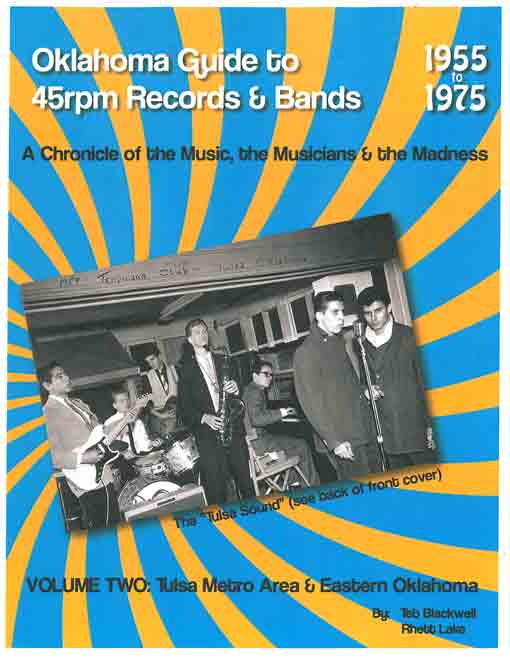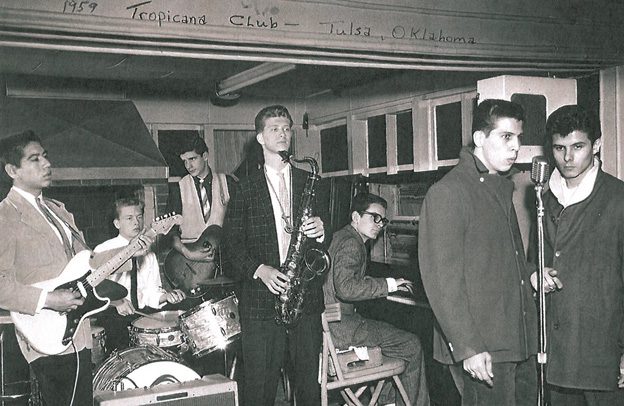At the very beginning, he recalls, it was all going to be a lot simpler. A record collector known for his vast number of 45rpm discs on Tulsa labels, Blackwell was contacted in 2007 by another aficionado, Rhett Lake. As it turned out, Lake was putting together a discography of 45s that had been released by Oklahoma labels and wondered if Blackwell would help him out.

“He had lived all his life in Oklahoma City,” Blackwell recalls. “Like me, he was a non-musician, but he’d always been interested in the music and the bands. We started talking back and forth, and we talked to band members about their records, and then we began to realize there were many, many more bands that didn’t make records, but still deserved a story.
“So it started out as a guide for record collectors, but then it opened up an avenue to really concentrate on the bands. One thing just led to another.”
Lake and Blackwell are listed as co-authors on both volumes of the Oklahoma Guide to 45rpm Records & Bands, although, as Blackwell explains, “To be honest about it, all I contributed to his was my Tulsa discography, and about all he contributed to mine was the existing Oklahoma discography. I wrote the stories in Volume Two, and he wrote the stories in Volume One.”
Blackwell readily notes that “it took me several years to get into the confidence of a lot of these people” he deals with in the book. However, he received early and invaluable help from the aforementioned Downing and Karstein, as well as Jumpin’ Jack Dunham, another important figure in Tulsa rock ‘n’ roll history. They provided Blackwell with leads, contact information and photos, and he was off to the races.[pullquote]So it started out as a guide for record collectors, but then it opened up an avenue to really concentrate on the bands. One thing just led to another.”[/pullquote]
“I thought for sure that once I got the skinny on the Accents or the Starlighters or some of [keyboardist-vocalist] Larry Bell’s bands, I’d just think, ‘Wow,’” Blackwell says. “But I really enjoyed learning about them all.
“One of the things that startled me,” he adds, “is how many of these people went out to California, or went on tour, and made a livelihood out of their music. Karstein did well, Dunham wrote a heck of a lot of songs that were recorded, and there were just lots of others who became professional musicians after getting started back in high school.”
And while he’s justifiably proud of the book’s stories and the people they celebrate, the collector side of his psyche has also been fulfilled.
“As a collector, I’ve been aware of bands like Marble Phrogg, Totty, Xebec and the Skeptics, because of the value of their records. Collectors throughout the world, and I mean that, pay big bucks for their records. Now, I finally have those bands in print, and they get a correct discography, right out of the mouths of their musicians.”
Blackwell even managed to uncover evidence that contradicted his long-held notion about Tulsa Sound godfather Leon Russell’s first record. It is not, he found out, the 1957 Accents single “Lovin’ at Night.”
“I was talking with [saxophonist] Johnny Williams, and he told me that [future country star] Mel McDaniel, when he was working in Tulsa filling stations and playing little clubs, wrote a ‘teener,’ which is what record collectors call a kind of broken-hearted doo-wop song from the late ‘50s. He was going to record it, and he needed a B-side, so he took one of [JJ] Cale’s songs called ‘Lazy Me.’ Johnny said that he and Cale and Leon went to the studio and recorded it in the latter part of 1956, which would’ve been before ‘Lovin’ at Night’ was recorded. It was released on the local Galway label.
“So,” he concludes with a laugh, “go out and buy a copy of ‘Candee’ right now. Leon has such a following that I’ll guarantee you it will go up in value.”
Oklahoma Guide to 45rpm Records & Bands – Volume Two: Tulsa Metro Area & Eastern Oklahoma, is on sale at four Tulsa locations: The Snow Goose, Dwelling Spaces, Ida Red Boutique and Decopolis.


























